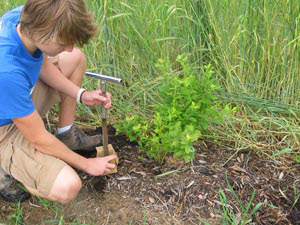Summary
Investigator: Eric Hanson, Michigan State University, East Lansing, MI
Project location: southwestern Michigan and north central Indiana
 Blueberries are considered a healthy food and the demand for organic blueberries continues to exceed the supply. In Michigan, the largest blueberry-producing state in the U.S., less than 0.01% of the acreage is certified organic. Blueberries are grown on a variety of soil types and growth and production are highly dependent on adequate nitrogen during the late spring and early summer. An issue consistently identified by organic blueberry growers is to understand how their use of surface mulches to control weeds affects fertilizer needs, as mulches can dramatically affect N availability. The question is complicated by the fact that growers use a wide variety of locally available and economical nutrient sources (composted manures, feather meal, commercial organic fertilizers) and organic mulch materials (bark, wood chips, straw, leaves, peat).
Blueberries are considered a healthy food and the demand for organic blueberries continues to exceed the supply. In Michigan, the largest blueberry-producing state in the U.S., less than 0.01% of the acreage is certified organic. Blueberries are grown on a variety of soil types and growth and production are highly dependent on adequate nitrogen during the late spring and early summer. An issue consistently identified by organic blueberry growers is to understand how their use of surface mulches to control weeds affects fertilizer needs, as mulches can dramatically affect N availability. The question is complicated by the fact that growers use a wide variety of locally available and economical nutrient sources (composted manures, feather meal, commercial organic fertilizers) and organic mulch materials (bark, wood chips, straw, leaves, peat).
The primary project objective is to describe the impact of fertilizer and mulch types on nitrogen availability in the soil and plant health in organic blueberry systems.
We propose to study the interactions of mulch materials and nutrient sources in order to develop guidelines to assist farmers to adjust nutrient additions to compensate for N retention in mulches. In addition, plant growth and nutrient status and mycorrhizal activity in the roots will also be assessed. This research will be done on organic farms complemented by a replicated organic field trial on a university research farm along with a soil column study to monitor nitrogen dynamics in a controlled environment. The outcome of this project will be research-based guidelines for optimizing mulch and fertilizer use in organic blueberries.
